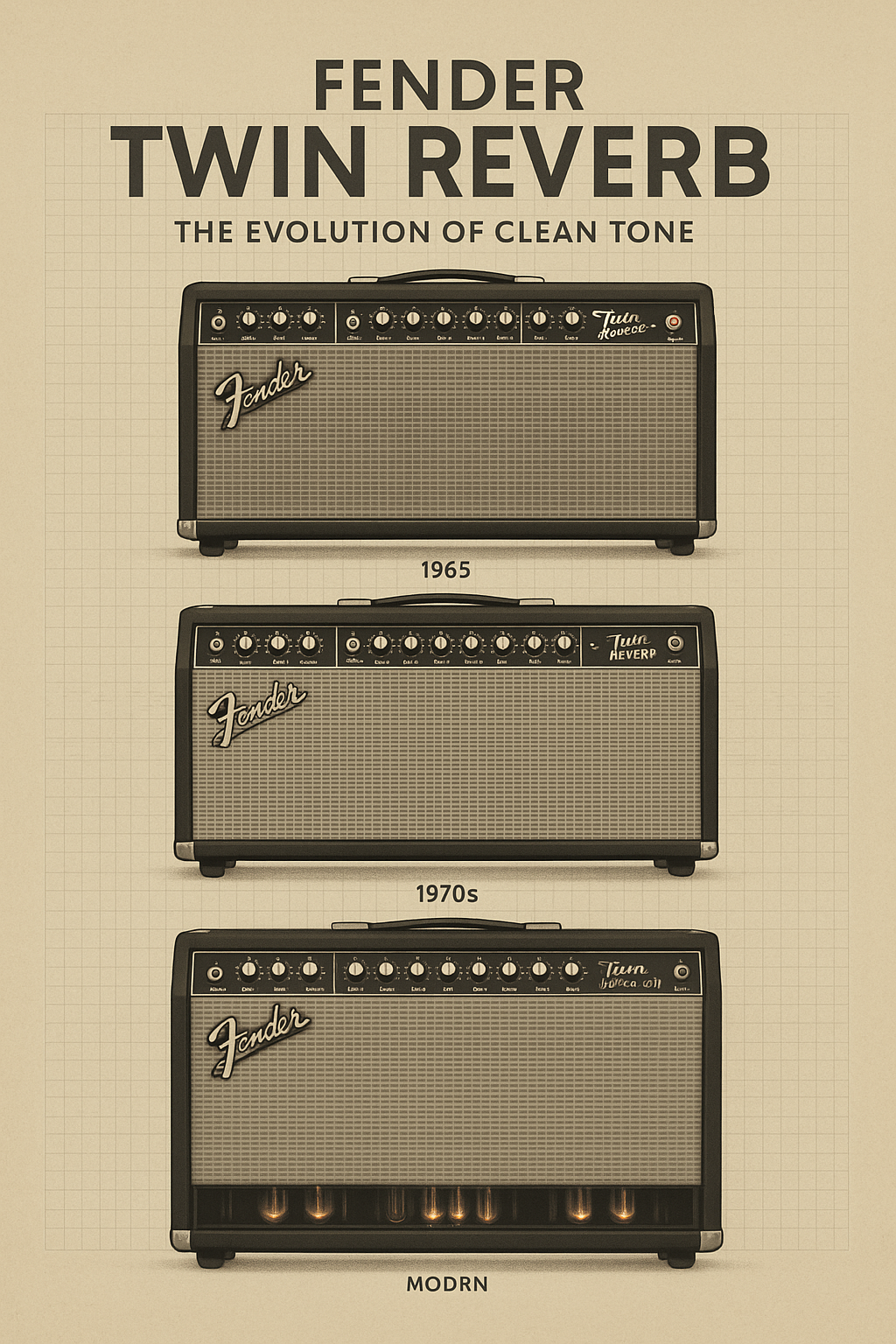Introduction
Few amplifiers are as revered and enduring as the Fender Twin Reverb. Since its debut in the early 1960s, it has become a cornerstone of guitar tone — synonymous with clarity, volume, headroom, and lush built-in reverb. Used on countless recordings and favoured by genre-defining players, the Twin Reverb has seen decades of evolution, from black panel glory to silver panel experimentation and modern reissues. This is the story of a true amplifier legend.
Early Roots: Pre-Twin Reverb (1952–1963)
The Twin Reverb’s DNA traces back to the original Fender Twin Amp, introduced in 1952 as a 25-watt tweed combo with two 12” speakers. Throughout the 1950s, the amp underwent incremental changes — more power, better transformers, and circuit tweaks — culminating in the 80-watt brown Tolex version of 1960.
But the true game-changer came in 1963, when Fender launched the Twin Reverb, adding built-in reverb and vibrato, and introducing the now-iconic black control panel.
The Black Panel Era (1963–1967): The Clean Standard
The black panel Twin Reverb is widely considered the pinnacle of the amp’s legacy. These amps offered:
-
85 watts of ultra-clean power
-
Two 12” Jensen speakers (later Oxford and JBL options)
-
Fender’s lush spring reverb and warm, rich vibrato
-
Beautifully scooped mids and sparkling highs
-
Loud headroom ideal for clean playing
Designed during the last years of Leo Fender’s ownership (before CBS acquisition in 1965), early models carried the “Fender Electric Instruments” logo plate, replaced by “Fender Musical Instruments” after CBS took control.
Why it mattered: The black panel Twin Reverb became the gold standard for clean electric guitar tones. Country pickers, surf players, bluesmen, and jazz guitarists adopted it quickly — its power and clarity outshined almost every other amp on the market.
The Silver Panel Era (1968–1982): Tweaks, Power, and Pushback
Following CBS’s takeover, Fender began tweaking its amp lineup cosmetically and electronically. In late 1967, the Twin Reverb got a visual makeover: the silver panel control face with blue “tailless” logos, aluminium trim, and sparkling silver/blue grills.
But changes weren’t just skin-deep:
Key changes during the Silver Panel era:
-
1968–69: Bias balance circuit added (replacing adjustable bias)
-
1972: Introduction of master volume control
-
1974–76: Addition of pull-boost, hum balance, and other features
-
1977: Shift to ultra-linear transformers, boosting power to 135 watts
-
Speaker shifts: JBLs and Utah speakers common in later years
While the silver panel Twin remained popular for its brute volume and clean fidelity, many purists felt the CBS-era circuit tweaks dulled the amp’s tone — cleaner, louder, but less musical at lower volumes. The scooped midrange became more pronounced, and the reverb circuitry was subtly altered.
Still, in the right hands, silver panel Twins delivered enormous clean tone with headroom to spare — and saw wide use on large stages where clarity and power mattered more than break-up.
Reissues and Modern Twins (1982–Present): A Return to Roots
In the early 1980s, Fender began reverting to the black panel aesthetic and circuitry. By 1982, the original Twin Reverb was discontinued. However, the demand for vintage tone remained strong.
Fender’s modern offerings include:
-
’65 Twin Reverb Reissue: Meticulously recreates black panel circuitry with tube-driven reverb, bright switches, and period-correct aesthetics
-
Custom 68 Twin Reverb: Warmer midrange voicing and reduced negative feedback for earlier breakup
-
Tone Master Twin Reverb: Digital amp modeling with incredible fidelity, lighter weight, and silent recording options
These amps brought back everything players loved about the original Twins — shimmering highs, massive headroom, and unmistakable reverb — while embracing modern needs like reliability, weight savings, and versatility.
Famous Players of the Twin Reverb
Over the decades, the Twin Reverb has been used by an astonishing range of artists:
-
Michael Bloomfield – His searing blues leads with The Paul Butterfield Blues Band and on Super Session were shaped through a black panel Twin.
-
Keith Richards – Frequently uses a Twin Reverb on stage, especially in combination with low-wattage amps like the Champ.
-
Johnny Marr – Known for shimmering, chorus-laced clean tones with The Smiths, often used a Twin in tandem with other Fender amps.
-
Eric Johnson – Has employed the Twin Reverb in studio settings for clean rhythm tones and lush reverb trails.
-
Tommy Emmanuel – Uses the Twin Reverb for its pristine clarity and natural response to fingerpicking dynamics.
-
Steve Jones – Used a Twin Reverb to record the legendary Never Mind the Bollocks album — an unexpected choice for punk, but proof of its versatility.
-
Jerry Garcia – Often ran a Twin head into McIntosh power amps and JBL speakers for his signature crystalline tone with the Grateful Dead.
Famous Recordings Featuring the Twin Reverb
While it’s tough to trace specific tracks to a single amp (especially in multi-amp rigs), here are some landmark recordings where the Twin Reverb played a role:
-
The Paul Butterfield Blues Band – East-West: Michael Bloomfield’s soaring solos were sculpted through a Twin Reverb and a Gibson Les Paul.
-
The Smiths – The Queen is Dead: Johnny Marr’s jangling, textured clean tones are deeply tied to Fender Twin Reverb voicing.
-
Grateful Dead – Live/Dead: Garcia’s live tone came largely from a modded Twin Reverb head.
-
Sex Pistols – Never Mind the Bollocks: Despite being a punk milestone, the distorted wall of guitars came from a cranked Twin Reverb, expertly EQ’d and mic’d.
Why the Twin Reverb Remains Relevant
-
Unmatched Headroom: Perfect for pedals, live gigs, and players who want clean tones at high volume.
-
Built-In Spring Reverb: Arguably the most iconic and lush reverb in amp history.
-
Dual Channels: Useful for switching between rhythm and lead, or guitar and keys.
-
Vintage Appeal: From the stage to the studio, the visual and sonic aesthetic of the Twin Reverb still turns heads.
Conclusion: The King of Clean
The Fender Twin Reverb has earned its place in the pantheon of legendary gear. Whether in its 1960s black panel prime, roaring silver panel stage presence, or modern reissue form, the amp continues to be a benchmark for clean, articulate tone.
From blues and jazz to punk and pop, the Twin Reverb has proved itself in every setting — not just a relic of the past, but a timeless tool for tone chasers everywhere.









